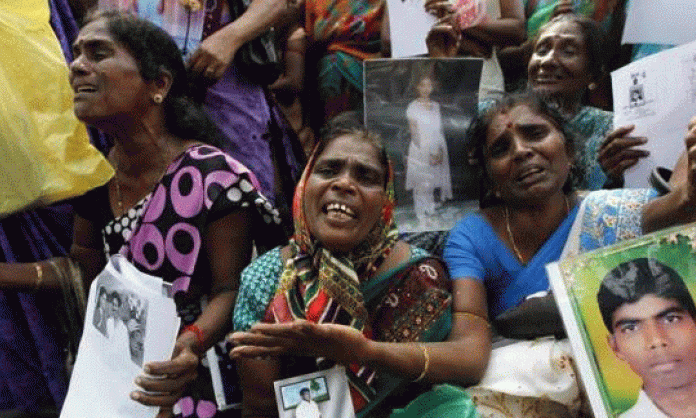Six years after the end of Sri Lanka’s civil war, Tamil lands, particularly in the north of the island, remain under military occupation. Local populations often live in fear, as military abuse, rapes and disappearances continue.
The 26-year civil war, which claimed the lives of some 200,000 people, concluded in 2009 when the Sri Lankan armed forces launched a bloody offensive to destroy the Liberation Tigers of Tamil Eelam, which had led the Tamil national liberation movement for several decades.
The final push claimed the lives of tens of thousands, and has been widely-condemned as an act of genocide in which unspeakable acts of cruelty were carried out on a largely defenceless population.
According to the government, the end of the war ushered in a new peace across the country and has been pivotal to Sri Lanka uniting as a nation. However, a new report published by the Oakland Institute, a US think tank, has documented the continued ethnic cleansing and cultural genocide being carried out by the Sri Lankan regime.
“A silent war continues under a different guise”, writes Anuradha Mittal, who authored the report, The long shadow of war. “Thousands of Tamils are still internally displaced and remain without land or livelihoods.
“In 2014, at least 160,000 soldiers, almost entirely Sinhalese [the majority ethnic group], were estimated to be stationed in the north.” That’s one soldier for every six civilians.
“This military occupation is not about ensuring security. The army has expanded non-military activities and is engaged in large-scale property development, construction projects, and business ventures such as travel agencies, farming, holiday resorts, restaurants, and innumerable cafes …
“The army officially runs luxury resorts and golf courses that have been erected on land seized from now-internally displaced peoples …
“Over the past six years, the process of Sinhalisation has intensified with an aggressive government-led effort that systematically replaces Tamil culture and history with victory monuments dedicated to Sinhalese hegemony and Buddhist religion on the ruins of the Tamil homeland.”
The war’s brutal conclusion, and the extended military occupation since, occurred under the rule of former president Mahinda Rajapaksa. The Sri Lanka Campaign for Peace and Justice estimates that, since the end of the civil war, the size of the military has doubled.
In January, Rajapaksa was defeated by one-time ally Maithripala Sirisena in fresh presidential elections. Sirisena positioned himself as a reforming figure. His manifesto, A compassionate Maithri governance – a stable country, pledged to devolve the executive power of the presidency to a new parliament, rewrite the constitution and tackle corruption.
But it rejected any moves toward an international investigation into war crimes committed during the final stages of the civil war. Sirisena also pledged to protect Rajapaksa and army top brass involved in the genocide. He refused calls from the Tamil National Alliance, which swept provincial elections in the north, for measures to devolve power to representative bodies in the Tamil areas.
Yet the promise of political change resulted in Tamils backing the challenge to Rajapaksa. “Sirisena came to power with Tamil voters support”, said MK Shivajilingam, a member of the Tamil Eelam Liberation Organisation (TELO). “There are 300 Tamil political prisoners, but so far none have been released … There are 18,000 Tamils still missing; so far the government hasn’t given any details of where they are or what happened to them”. Other reports suggest 70,000 or more still unaccounted for.
Shivajilingam, a former member of the Sri Lankan parliament, was in Melbourne to commemorate Tamil Genocide Remembrance Day on 18 May. He told Red Flag that land theft, harassment and intimidation were continuing issues.
“Nearly 100,000 acres of estate and private land in the north and the east were taken by the state and security forces from 2009 up to 2014. More than 200,000 acres in total land have been taken. Only around 2,000 acres have been released [back] to the public.
“Sirisena promised to do something [about the land] but he can’t.”
Shivajilingam and the Tamil National Alliance, of which he and the TELO are aligned, want the Tamil national question to be solved through a federal constitution that gives political autonomy to the north and the east. However, he said that there is little chance of this happening given the current forces in the Sri Lankan parliament, which are either unable or unwilling to recognise Tamil claims.
Another obstacle is the military. It remains powerful. The generals want to maintain troop numbers in order to preserve the army’s institutional weight and their own political influence. They can only do that by playing up the so-called Tamil security threat and continuing the occupation of Tamil lands.
Further, the officers’ moves into the civil economy will, even if significant troop reductions occur in the coming years, help to entrench the process of Sinhalisation, thereby giving democratic pretext to reject Tamil claims for self-determination in the future. Their actions are similar to the settler colonial “facts on the ground” strategy employed by Israel in Palestine, Indonesia in West Papua and, of course, Australia against the First Nations.
Yet another obstacle is the international support that the Sri Lankan government and military receives. While limited pressure was applied to the Rajapaksa regime, the change of government and a few token gestures – such as the paltry gestures on land redistribution – have given the Sri Lankan state even more breathing room.
The absence of any reckoning for the crimes committed against Tamils remains a sticking point. “The truth must come out”, Shivajilingam said. “We need international support – from progressive and labour forces – to build pressure for an independent investigation and truth commission.”










